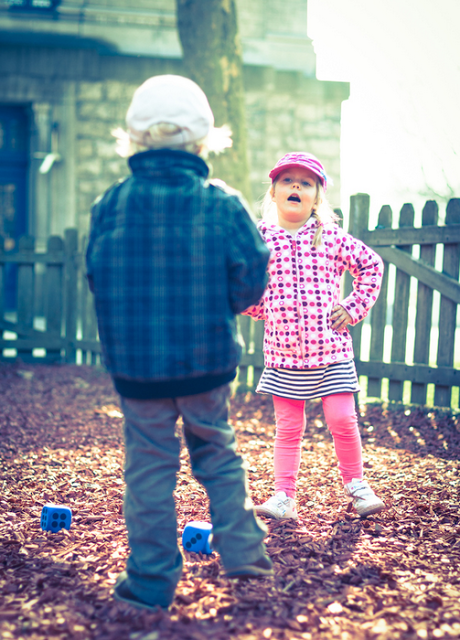From the moment I awoke, I felt a sinking feeling.
I replayed the incident the night before when my sister and I ended our night in an argument. Personal judgements, feelings about parenting, old wounds triggered angry voices. All of it designed to hide something deeper…the real issue…our pain, uncertainty, sadness.
We would reconnect soon, I resolved. Unaware she had already sent me a late night text offering love and connection, my wise elder sister reminded me that we love each other more than we were angry.
Now, with new eyes, an open heart and calm voices, my sister and I found our way to the right words and tones which would create new expansive point of views, heal some deep issues, and learn new moves to mitigate this misunderstanding in the future.
Later on that day, as I watched my two kids arguing about who got to the kitchen seat first, I became even more aware of the importance of teaching kids how to handle conflict in way that is healing and transformative—so that we can instil the confidence and joy of working things through with their siblings and others throughout their life.
Conflict after all, is a great teacher. With it, we get windows into our pain, our insecurities our fears. Whenever conflict is swept under the rug or not dealt with in it’s entirety, the full spectrum of healing and learning can never occur.
This is how resentment and frustrations remain and build.
We have been socialized towards a deep aversion to conflict but, like a muscle, this skill must be developed. As long as we have two unique individuals with differing views, ideas and beliefs, conflict will rear it’s head. It will occur in the playground, in class with the teacher, in the home, at the neighbor’s house or at age 41 on your sister’s couch.
With new skills, kids can build resilience, reflect, empathize, and learn how to negotiate towards a resolution. They will develop tolerance, forgiveness and emotional control, which is what we want for our children.
Since it is virtually impossible to move past a wound without diving in and figuring out what caused it, then we must learn how to to dive in.
It starts with finding the teachable moments.
The moments that bring together the perfect combination of time and space, where we and our children are receptive, not reactive. We need to choose a time where we are listening deeply in order to offer support and guidance.
To do this well we must build our self-awareness and get present to our biases and beliefs.
What we observe when our children interact is a small percentage of what’s actually going on. With all things, there is always a conversation going on under the conversation, and it is there where our kids’ real torment, sadness and hurt lie.
Our job as parents is to ask questions, become extremely curious, and figure it out.
This is an art form that can be developed.
If we dive in too soon, we risk having kids not figure things out for themselves.
If we speak during the height of the disagreement, we risk flared tempers and no listening will occur.
If we choose the wrong place, we risk our child feeling singled out and embarrassed
If we are triggered ourselves, we risk our effectiveness in calming the situation
If we are not aware about our own blind spots or emotional triggers, we risk unconsciously laying blame and marginalizing one child, so one or both see you as unjust.
It’s a juggling act but one that gets easier the more we practise and the payoffs are immense.
So how do we resolve conflicts in a way that promotes peace and gives kids new tools in their arsenal?
Here’s a start:
1. Ensure we are calm before we interact with them.
For example, trying to shout across the house to “knock it off,” does not create understanding just as our subconscious anxieties about one child’s selfishness will never serve the greater good. So start off by giving yourself a mini time-out to regulate your emotions so that you can remain calm and lead effectively, without creating more distance and resentment.
2. Look for teachable moments.
Long before an argument or fight breaks out, look for teachable moments. Get down to your children’s eye level and explain to both kids they are going to talk about what works and does not work for them.
Have one child explain three things they don’t want the other to do or say. For example, “No licking my face, no rough play and no butting in front of me.”
The second child then repeats what they heard. For example, “What my sister wants is for me to not to lick her face, play rough and butt in front of her.”
(If they forget the three things then the other repeats it they’ve nailed it)
3. Do the same in reverse.
4. Ask for each of their commitment to each others requests.
What makes this effective:
Over the next while, consistently ask each child what they remembered about what’s important to the other. This allows them to clarify and repeat, then check in every day to see if each child has had their needs met at the end of the day.
Despite our bewilderment and feelings about the triviality of the argument, the issues are usually not about a toy, opportunity, or a kitchen seat; they are more often about feelings and perceptions that have been quietly building up. When we start to explore this space we often find that one child was feeling less important, unloved or misunderstood and the feeling manifests in a battle of egos and a power struggle.
Since we never know the whole story, we must try to approach the conflict from a mindset of naivety. Instead of assuming, we must remain curious and questioning.
So when kids are feuding, we can try saying the following:
I can see you are both angry right now. Let’s take a moment to calm down and breathe deeply, so we can understand each other and find a way through this.
What happened? How is this making you feel inside? Can you each name three ways you can both can resolve the issue?
Deep down, all conflict is a cry for more love, more touch, more acceptance, more understanding.
Fighting with our siblings can be both a training ground and trampoline for navigating conflict.
When handled well, conflict allows us the opportunity to get a deeper, more intimate understanding of each other—a richer awareness that can only be reached when we are open to seeing our patterns, insecurities, and feelings head on.
If we can teach kids how to maneuver this space masterfully and master these skills ourselves, then we will transcend our fears, insecurities, and sadness and approach those we are closest to with curiosity and questions so they always feel loved and accepted, above all else.
Love elephant and want to go steady?
Sign up for our (curated) daily and weekly newsletters!
Author: Rhea Lalla
Editor: Renee Picard
Photo: Max Mayorov at Pixoto











Read 0 comments and reply